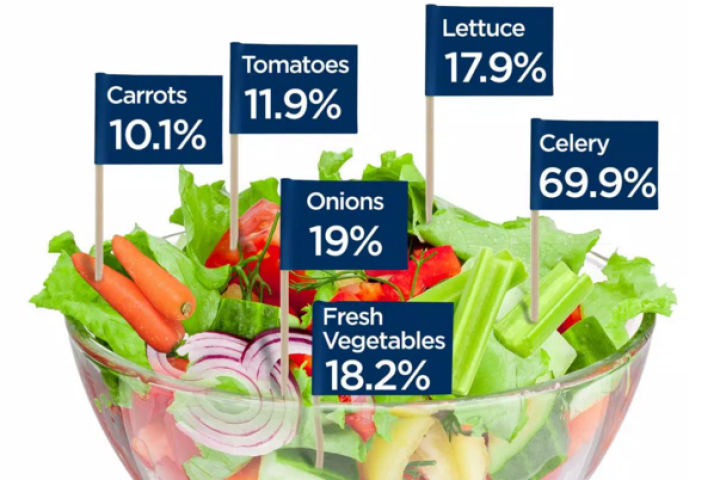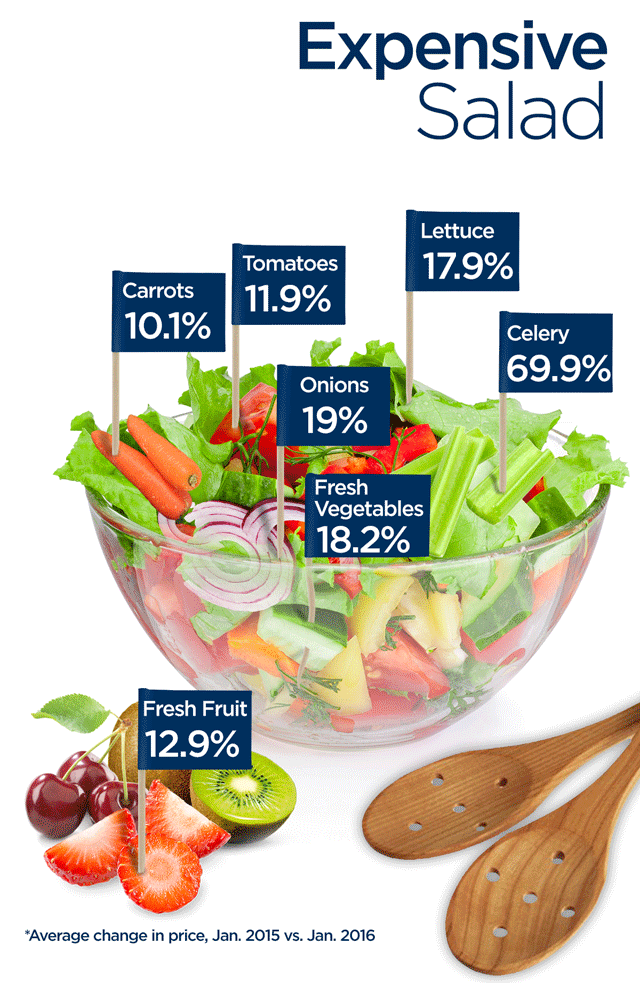Feel like it’s too expensive to eat healthy? You’re not alone.

The price of celery climbed by 69 per cent in the last year. With soaring inflation rates, grapefruits are now 28 per cent more expensive, onions are 19 per cent pricier and staples like lettuce and apples now cost about 17 per cent more.
The sticker shock at the grocery store may be making it tricky to feed your family healthy fare, experts say.
“These increased prices are manageable for many people, but for some this could be the line for them where it really could cost too much,” Jennifer Sygo, a Cleveland Clinic Canada registered dietitian, told Global News. “For the average person who hasn’t put a ton of thought into it before, this is a great opportunity to look at everything a little more carefully.”
READ MORE: Forget cauliflower – celery leads pack of runaway food prices
Yassamin Gharai, a registered dietitian at Lakeridge Health, says an average family of four could spend up to $1,000 a month on stocking the fridge with fresh produce for healthy meals.
With food prices steadily climbing, Food Secure Canada is warning that consumers’ health and well-being are going to take a hit. Sixty per cent of calories Canadians consume already come from ultra-processed food.
“Rising prices for fresh fruits and vegetables will only exacerbate unhealthy eating trends and increased food insecurity,” the organization said.
READ MORE: Food prices surge as vegetable costs spike 18.2 per cent
Sygo and Gharai provide tips to help consumers eat healthy while food prices stay high.
Create a shopping list: Your days of blindly grocery shopping are over if you’re trying to stretch your food budget. Sygo says your family needs to sit down to plan out how many meals you’ll need to cover for so you don’t end up with waste.
Then you’ll need to comb through flyers to figure out what to make based on what’s on sale. With your meal plan in tow, you’ll have a shopping list with a set budget so you don’t overspend.
READ MORE: The 41 most nutrient-dense fruits and vegetables
“You’ll know what you’re going to eat that night, you’ll take chicken out of the freezer and have the ingredients in your fridge. That’ll stop you from impulse buying or getting takeout,” Sygo said.
Buy frozen fruits and vegetables: There’s a misconception that frozen foods aren’t healthy or are a lesser version of their fresh counterpart, but that’s not true, both experts say.
“Frozen foods maintain a majority of nutrition and, in some cases, have more nutrition depending on how quickly the produce was picked until it was flash frozen,” Gharai said.
“It could be the case that the frozen option has retained more nutrition because they’re typically frozen at peak as soon as they’re harvested,” she explained.
READ MORE: What’s the best way to cook vegetables? Steaming, study says
Berries are often bought in frozen bags, but broccoli, cauliflower (which has seen a steep climb in prices when fresh), green beans and carrots are also great examples.
Fill up on beans: Lentils, chickpeas and beans can be purchased in cans or dry, and you can rehydrate them. Either way, they’re incredibly healthy, satiating and cheap, the experts say.
“They have a wonderful array of benefits in that they’re fibre-rich, protein-heavy and they’re filling,” Sygo said. A single bag of dried white beans could go for about $2 yet they’d provide a few portions for meals.
READ MORE: Why you should eat beans, lentils and peas to lower bad cholesterol
They’re incredibly versatile, too: Add beans, lentils and chickpeas to chili or soups, make salads and even use them to plump up your burgers or stews, Sygo suggests.
Don’t forget – not every grocery store staple went up in price: While celery and cauliflower skyrocketed out of reach, cucumbers and broccoli have stayed relatively the same, Gharai said.
It’s import costs and a weak Canadian dollar that are driving prices up. With that in mind, shop for produce that’s locally grown, Sygo notes.
Butternut squash, turnips, rutabagas and potatoes are grown in Canada so access is readily available.
Get into batch cooking and freezing extra portions: If certain items are on sale at the grocery store, it’s okay to load up on them as long as you use the produce.
“You have an opportunity to make something from these groceries that you can freeze and that can be an easy way to reduce costs and have healthy nutritious meals,” Gharai said.
READ MORE: Some of the worst foods for your heart’s health
“Batch cooking helps students, busy families and people struggling financially.”
Always label your dishes so you know what you’re throwing into the freezer and when it was first prepared.
Make substitutions: If you used to feed your kids almonds and pears as a midday snack, you might decide to swap them out for sunflower seeds and apples, Sygo said.
If apricots are too pricy, reach for raisins, she adds.
“You’re still getting nutrition, so it’s just a matter of simple substitutions,” she said. Buying the no name brand over the brand name also helps to cut costs, too.
Buy less expensive cuts of meat: If the price of protein seems out of reach, opt for the cheaper cuts even if they require extra preparation.
READ MORE: Soaring Canadian vegetable prices hit their highest point this century
“They’re tougher and take more time to cook but don’t let that dissuade you especially if the price of meat is ridiculously high,” Gharai said.
Opt for whole foods over prepackaged goods: If you’re used to buying individually-packed portions of oatmeal or carrot sticks or crackers with cheese or hummus, now’s the time to add food preparation to your schedule to save money.
A bagged salad is going to be pricier than buying a head of lettuce you’ll have to chop up along with shredding carrots and slicing cucumbers.
“Buy a head of cabbage, do the prep at home yourself and you’ll have the vegetable on hand for at least a week to work with,” Gharai said.
Fresh vegetable prices in Canada, 2000-16
carmen.chai@globalnews.ca
Follow @Carmen_Chai





Comments